Research Article - Volume 3 - Issue 1
Prevalence of low back pain among christian and muslim faithfuls in a nigerian university
Ojoawo Adesola Ojo*; OlagokeSerifdeenTolulope
Department of Medical Rehabilitation, Faculty of Basic Medical Sciences, College of Health Sciences, Obafemi Awolowo University, Ile Ife, Nigeria.
Received Date : Dec 08, 2022
Accepted Date : Jan 10, 2023
Published Date: Jan 31, 2023
Copyright:© Ojoawo Adesola Ojo 2023
*Corresponding Author : Ojoawo Adesola Ojo, Department of Medical Rehabilitation, Faculty of Basic Medical Sciences, College of Health Sciences, Obafemi Awolowo University, Ile Ife, Nigeria.
Email: aoojoawo@yahoo.com
DOI: Doi.org/10.55920/2771-019X/1362
Abstract
Background: Prevalence of low back pain among Muslims and Christians have been reported separately in literature, but not compared in Nigeria.
Objective: The objective of the study was to survey the prevalence of low back pain among Christians and Muslims in Obafemi Awolowo University Ile Ife.
Methods: Two hundred and forty respondents (120 Christian and 120 Muslims) were recruited for the study. A standardized questionnaire adopted from a study in India was used for the study. Each respondent was given a copy of the questionnaire to complete which was collected as soon as possible. Data was analyzed using descriptive and inferential statistics and alpha level was set at 0.05.
Results: Result shows that point prevalence of low back pain was more among Muslim (98, 81.7%) respondents, than that of Christians (62, 60%). In the last 12 months, 104(86.7%) Christians and 85 (70.8%) of Muslims reported pain. with respect to 12 months absent from the work 44(45%) Christians and 36 (30%) Muslims respondents were involved; there was a significant association between prevalence of low back pain and religion (X2 = 14.415, P = 0.001). Posture was the major cause of low back pain with 78 (65%) Muslims and 47 (39.2%) Christian respondents.
Conclusion: The study showed that the pointprevalence of low back pain was more among Muslim than Christian while the 12 months prevalent was more among Christians than Muslim and but more Christians were absent from work as a result of back pain.
Introduction
Low Back Pain (LBP) is a global health challenge, the most prevalent orthopedic condition and one of the major causes of functional limitations [1-3]. Low back pain life time prevalent was reported to be as high as 84%whereas the estimated prevalence of chronic LBP was above 23% [4]. In Africa Louw, et al reported that the prevalence of low back pain among the adolescent was 12% and that of adult was 32% [1]. In south-western part of Nigeria where nine hundred adults were selected using multisage sampling technique, it was discovered that 40% of the population had low back pain in the last 12months while 33% had low back pain at the time of study [5]. The term low back pain clinically refers to as the episode of pain in the lower back which is often related to a specific or non-specificprecipitating event. It is however defined byKoes [6] as the muscle tension or stiffness localized below the coastal margin and above the inferior gluteal folds with or without sciatical (leg pain). Low back pain could also be classified traditionally by acute, sub-acute and chronic [i.e. 6 weeks, 6-12 weeks and 12 weeks respectively [7].
Low back pain could manifest with any of the followings: Sclerotomal pain; which is pain from an area of the bone and fascia supplied by a single nerve root, Radicular pain; which is the single nerve root compression that does not produce neurogenic loss. Other manifestation of low back pains are Dermatomal pain: which is the pain in the distributions of a single nerve root that may be associated with neurogenic loss [8]. Low back pain is a complicated conditions which affects the psychological impairment of pain, decrease muscular strength and endurance, balance, functional limitations and loss of spinal range of motion among others and the most common reason for seeking treatment among patients with low back pain [9].
Low back pain is the most reported work load burden for physical therapistapart from being a common orthopedic case which could be accompanied with a medical and neurologic conditions [10]. Although LBP may resolve, becomes recurrent and a few might persist however, it is considered as one of reasons for increase family expenditures as well as loss of jobs [11]. Islamic prayer, commonly represented by the Arabic term salat, is a form of meditation and praying is an important activity of daily living among Muslims across the world [12]. Solah the daily ritual prayer and one of the five pillars of Islam is obligatory upon all Muslims and is performed five time daily.A Muslim is expected to pray from age of 7years till death comes. This however result in a significant number of trunk movement, knee,hip flexion and extension over a life time an estimate of 70times a day [13]. Muslim prayers or solah involves standard physical motions such as standing, bowling, sitting and prostration which is significant for every Muslim to fulfil their religious responsibilities. And however this day to day activities demand greater ROM as compared to their western counterparts [14].
Activities such as vigorous dancing employed, clapping and jumping by Christians during services which involve a lot of trunk rotation, flexion and extension and prayer for empowerment [15]. These activities can predispose individuals to musculoskeletal injuries. Dancing, clap in African indigenous churches has different meanings from what it signifies ordinary. It may mean a natural manifestation of happiness and excitement. It may also mean an expression of rage, intenseness and contest [15].When intense prayer or worship such as of deliverance or invocation of the Holy spirit is offered, clapping, dancing, bending and standing and sitting are done in a rigorous manner. Great energies are engaged in these activities [15]. Dance in African indigenous churches is an integral mechanism of worship [15]. Several people feel that dancing is just a necessary activity perform either obligatory or unconsciously. About the spiritual significant of dance in African indigenous churches, it is important to note that vigor may be exerted while dancing during worship and this depends on the type of worship, that is the tempo of the dance is determined by the type of spiritual exercise being performed [15].
Literature reported on prevalence of low back pain in part of Nigeria. (Tella et al., reported the point prevalence of LBP to be 55.3% participants with gradual onset20.5%% sudden onset in a rural community in south western Nigeria [16]. Another study by Oyedero in Obafemi Awolowo University teaching hospitals Complex (OAUTHC) and Ilesha among nurses shows that 71.4% of the respondents had low back pain among which 88.7% had a low intense pain [17]. The study also showed that 54.1 % of respondent with low back pain got pain from nursing work which include (wound dressing, bed making, lifting and bending).
However, no significant study has been conducted to examine the prevalence of low back pain among religious group especially Muslims faithful and Christian in Obafemi Awolowo University Ile Ife, Osun state, Nigeria. The aim of this study is to survey the prevalence of low back pain among Christians and Muslims in Obafemi Awolowo University Ile Ife.
Material/Methods
Participants
Participants for this study were Muslims and non-Muslims faithful who reside and perform their religious duties in Obafemi Awolowo University in Ile-Ife, Nigeria.
Inclusion Criteria
Participants for the study were:
- Christians and Muslims faithful who are staff in Obafemi Awolowo University
- Christians and Muslims who does not involve in prayer like a faithful Muslims
Exclusion Criteria
Exclusion criteria for this study were:
- Christians and Muslimsfaithful that does not give his/her consent.
- Christians and Muslims faithful with a spinal pathology (including fractures, tumors, inflammatory disease, ankylosing, spondylolytis).
- Christians and MuslimFaithfuls with an underlying systemic, viscera disease, and previous low back surgery and pregnancy.
Research design
The research design for this study was cross - sectional survey.
Sample Size Determination
The sample size was determined using the Cochran”s formula below;

Therefore 240 respondents were recruited for the study.(120 Muslims and 120 non-Muslims)
Sampling Techniques: A purposive sampling was used for this study.
Instrument
The survey instrument for this study was a standardized questionnaire adopted from a study in India developed by Bindra, et al, (2013) which allowed the comparative assessment of low back pain among Christian and Muslims faith adherents in Obafemi Awolowo University [18].
The survey questionnaire was divided into 5 sections
Section A: This section was designed to obtain socio-demographic information like Name, age, sex, marital status, occupation and level of education of Participants,number of time prayer per day.
Section B: This section was designed to obtain information on the presence of low back pain, onset of pain, nature of pain, intensity of pain, severity of pain, activity limited by pain while praying and the prevalence of low back pain. Using pain rating scale ranging from 0-10 (with 0 means no pain,and 10 means worst pain)
Section C: This assessed the intensity of back pain in the last 12 months during Activities of daily living.
Section D: This assessed the health care services utilized for the low back pain.
Procedure
The ethical approval for the study was obtained from the Health Research Ethics Committee of the Institute of Public Health, College of Health Sciences Obafemi Awolowo University, Ile-Ife. The purpose and procedure of the study was explained to each participants and their informed consent was obtained.
The participants’ socio-demographic characteristicsand prevalence of low back pain were obtained by asking the respondents to respond to the appropriate section of the questionnaire. The survey questionnaire was administered and collected as soon as it was completed.
Data Analysis
Descriptive statistics of mean, standard deviation, frequency and percentages were used to analyze the data. Chi-square test of association was used to calculate the association between prevalence of low back pain, association between pain intensity and each of activity and socio-demographic factors among Christians and Muslim faithful. International business machine statistics statistical package for social sciences (IBM SPSS) version 21 was also used to analyze the data. Level of significance was set at 0.05.
Results
Socio-Demographic Characteristics OfRespondents
(Table 1) shows the percentage distribution of the sex, marital status, and educational level of both Christians and Muslims. fifty-two (43.3%) of the Christian participants were male, while Sixty-eight (56.7%) were female. Seventy-seven (64.2%) of the Muslim participants were male, while forty-three (35.8%) were female. The table also shows that the divorced participant were 22 (18.3%) and six (5%) in Christians and Muslims respectively, 85 (70.8%) and 98 (81.6%) were marred in Christians and Muslims respectively while the rest of the participants were single.
Table 1: Socio-demographic characteristics of participants N = 240
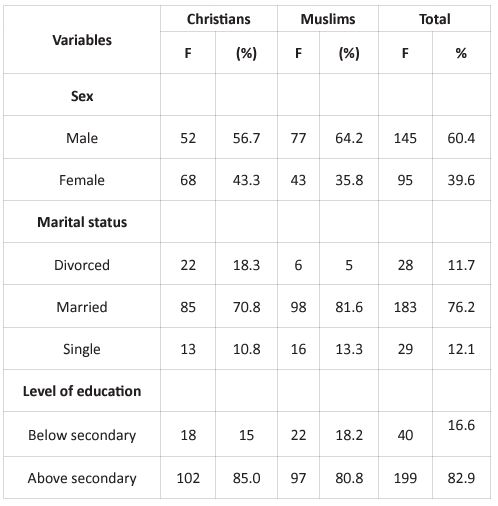
Occupational Distribution of Participants
(Table 2) shows the occupational distribution of the participants. Of the Christians, thirty-one (25.8%) were lecturers, twenty-two (18.3%) were nurses, thirteen (10.8%) were library officers and eight (6.7%) were lab attendants. Muslim participants consisted of almost same number of lecturers thirty (25.0%), a significant number of accountants fifteen (12.5%), secretary seven (5.8%), nurses nine (7.5%) and library officers nine (7.5%).
Table 2: Occupational Distribution of Participants N= 240
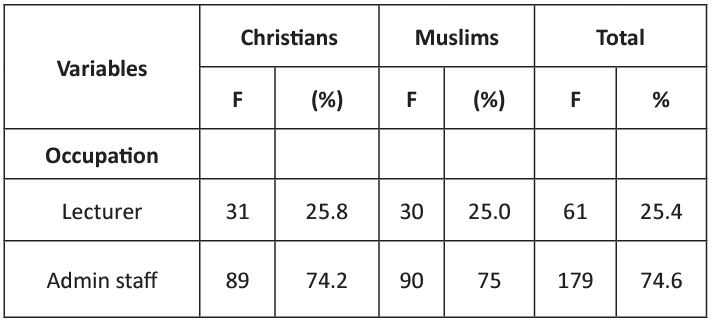
Comparison of Pain Intensity Between Christian and Muslims faithful
(Table 3) shows the comparison between Muslim and Christian pain intensity. It shows that there was no significant difference between Muslim and Christian pain intensity (t = 1.446, p = 0.149) also there was no significant difference between Muslims and Christian pain perception (t = 1.304, p = 0.194)
Table 3: Comparison of pain intensity between Muslims and Christians = N = 240

Point prevalence of low back pain among christians and muslim faithful
(Table 4) shows the point prevalence and pattern of low back pain among Muslim and Christian respondents. The table shows 98 (81.7%) of Muslims complained of present low back pain as compared to Christians, 72 (60.0%). Also 33 (27.5%), 19(15.8%) and 20 (16.7%) of the Christian participants reported “bad posture for a long time”, “trauma or injury”, and “sudden movement” as probable causes of their low back pain while 56 (46.7%), 22(18.3%), and 12 (10.0%) of the Muslims reported “bad posture for a long time”, “lifting of load”, and “trauma or injury” as probable causes of their own low back pain.
pain intensity between Muslims and Christians = N = 240
Table 4: Point Prevalence and Causes of Low Back Pain among Christians and Muslims N = 240
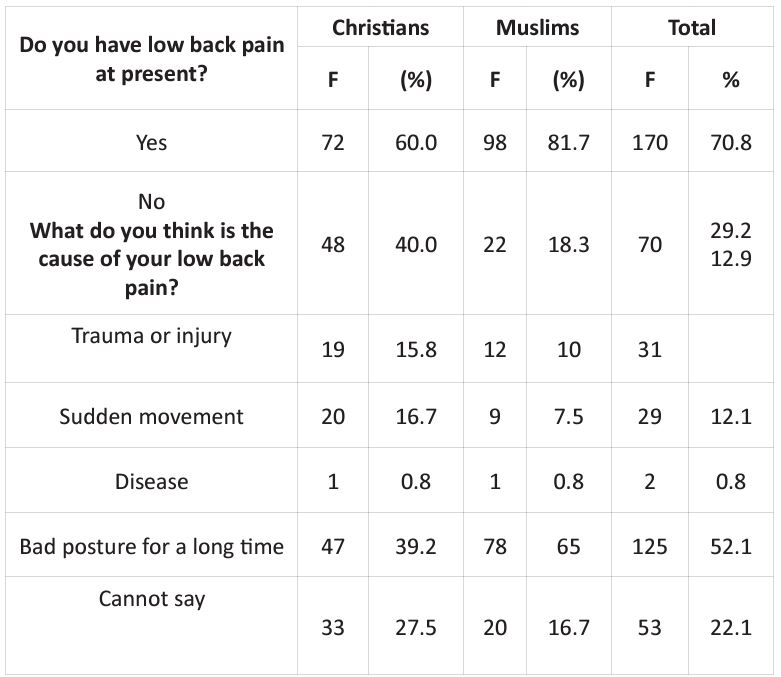
Description of low back pain
(Table 5) shows the description of pain among Christians and Muslims respondents. Fifty-eight (47.3%) Christians and 41 (34.2%) Muslims had gradual onset of pain, while 62 (51.7%) Christians and 79 (65.8%) Muslims had a sudden onset. Most Christians, 88 (69.2%) reported the pain was constant, while most Muslims, 62 (51.7%) reported it was intermittent.
Table 5: Description of Low Back Pain
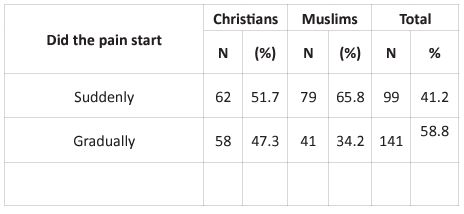
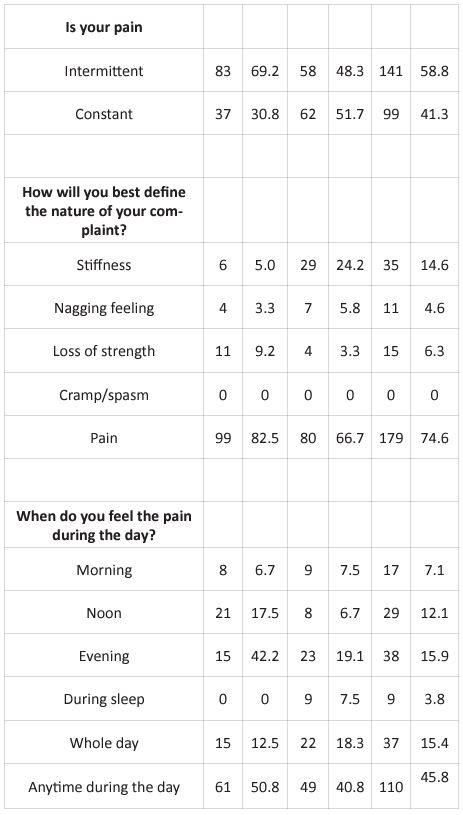
Pain during the last 12 months and absenteeism from work
Results from the table 8 shows that one 144 (86.7%) of Christians have had pain in the last 12 months while less Muslims, 85 (70.8%) have had pain. Fifty-four (45.0%) of the Christian respondents have been absent from work as a result of their pain and 10 (8.3%) were compensated for the days lost due to back pain, while only 36 (30.0%) of the Muslims have been absent from work as a result of their pain and 11 (9.2%) were compensated for days lost due to the back pain.
Table 8: Pain during the last 12 months and absenteeism from work
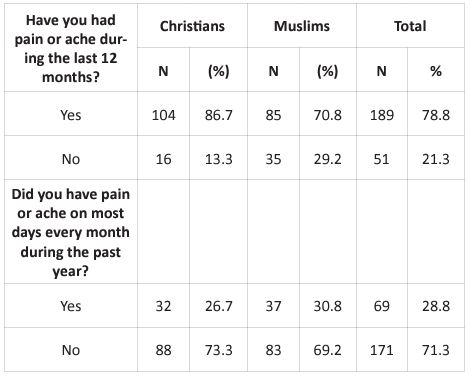
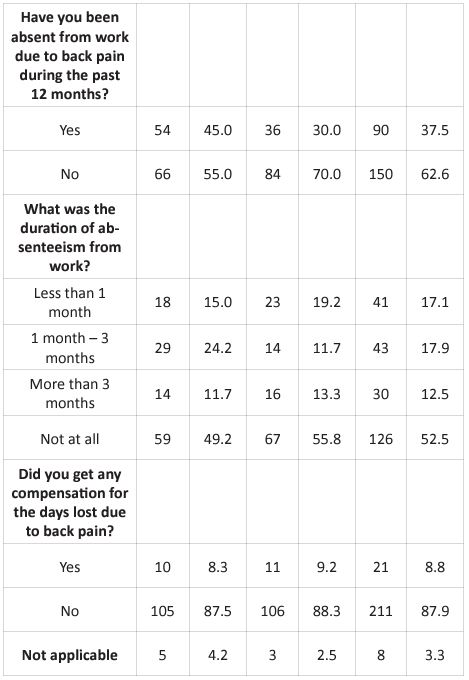
Association between low back pain and each of sex, marital status education level, religion, and occupation of participants
The results revealed that there was a significant association between prevalence of low back pain and religion (X2 = 14.415, P=0.001), but there was no significant association between the prevalence and each of sex (X2 = 0.619, P=0.430), education level (X2 = 6.129, P=0.218), marital status (X2 = 3.285, P=0.329), occupation(X2 = 17.064, P=0.216) and low back pain.
Table 9: Association between low back pain and each of sex, marital status, religion, and education level of participants
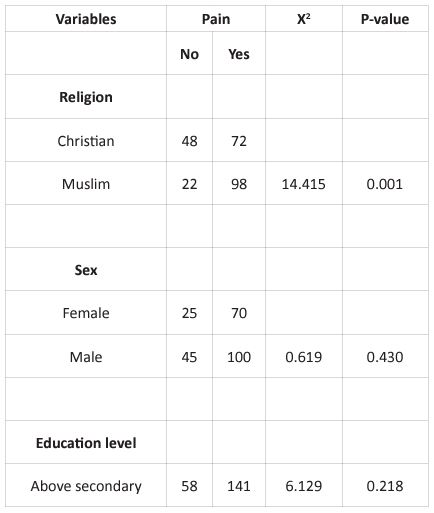
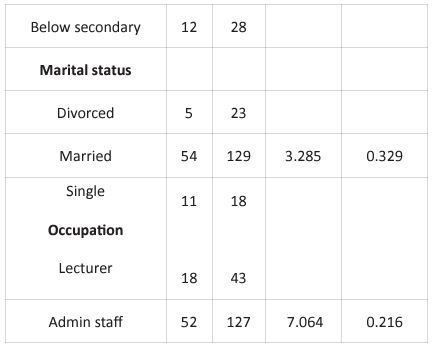
Discussion
This study was carried out to assess the prevalence of low back pain among Christians and Muslims faithful’s in Obafemi Awolowo University.
The study showed that for Muslim participants, male were more than the female, this may be because of Islamic believe, that women are tend to be restricted to house. While for the Christian female respondents were more than the male respondents. There were likelihood of two reasons for the findings of this respondents. There was a tendency that more female in the service of the University where the study were carried out or more females are in Christian faith than male. Considering the general population of the respondents, it will be observed that there were more males than female leaving us with the opinion that more females are in Christians faith than the male. The last point is supported by the study Swanson that submitted that around the world, females were found to be more religious in every religion including Christianity than the male [19]. Larger percentage of participants had completed their education up to tertiary level. The site of the study was in the University setting. It is expected that members of the staff will be hungry for knowledge therefore there is pursuit of academic, again, it is a strong requirement for any senior post in the University to have tertiary education, hence respondent needs to be qualified to be appointed. The study also shows that larger percentage of the respondents were administrative staff. It is arule of thumb especially in the Nigeria system that there are more non-academic or administrative staff in any University than the academic staff. This was documented by Ifedili as one of the recommendation from the National University Commission of ratio 1: 3 non-academic to academic staff in the nation University [20]. It can also be deduce from the study that there was no significant difference between Muslim and Christian participants pain intensity as well as pain perception. This shows that they both perceive and feel the pain in the same manner.
The study also showed that the prevalence of low back pain is more among the Muslimrespondents than that of Christian, in addition, there was a significant association between prevalence of low back pain and religion. This implies that all thing been equal, activities of Christians and Muslim especially during the religion practice may have an association with the prevalence of low back pain. One will observed that the domain where study was carried out was in the same setting, University environment, though there were other activities which individuals may be exposed to that could have resulted in to low back pain, the working environment and the ergonomicof the offices cannot be excused form risk factors. Not with standing, the activities in the church and mosque by Christians and Muslims faithful may have some contribution. Christians in their services usually sit down and stand up most of the times, sitting hour may be more than the standing hour. Be as it may both prolong sitting and prolong standing have been found to contribute to the occurrence of low back pain. Siting position has been associated with pain at low back [21]. Sitting position has also been found to contribute significantly to the development of low back pain [22]. Wilke et al (1999) submitted that there was upsurge in the pressure on the intervertebral disc during the sitting posture which predispose the disc into injury [23]. More so, the activities in the Muslim religion connote repeated sitting forward flexion and kneeling. This is done at least five times a day for every Muslim faithful. Repetitive wear and tear on the muscle, ligament, tendons, and disc in the spine associated with repetitive movement like twisting and bending, among others have been identified to be another major causes of low back pain [24]. These activities characterized the actions and operations in the service of the both Christian and Muslim religions.
The study also showed that large percentage of the respondents were absent from work because of their back pain which was more in among Christians than Muslim. Wynne-Jones et al, (2014) reported that back pain was responsible for a significant percentage of absence from work [25]. In addition, researchers have reported absence in the all work by 12.5% in the United Kingdom, one year prevalence of sickness absence due to back pain of 9% of in New Zealand and prevalence of absence of hospital workers of 32% in Ireland [26-28].
It was observed from the study that greater percentage of Christian respondents reported that the onset of the pain was gradual while greater percentage of Muslim reported sudden. Again more Muslim reported stiffness and constant pain while more Christians reported intermittent and less stiffness. Pain that occur suddenly has often been associated with a known injury among others and those with gradual onset has been related with possibility of osteoarthritis [29]. It may not be out of point to say that the repetitive action during the period of worship among the Muslim faithful may be a contributing factor to the sudden onset of low back pain among the Muslim respondents. In addition, the nature of the siting with no back support may be another factors. Whereas in the Christian activities, the prolong sitting on the chair again which may not be ergonomically compliant may be a contributing factors to the early spondylosis resulting in gradual onset of low back pain.
Conclusion
It can be concluded from the study that the prevalence of low back pain was more among Christians than Muslim faithful, while Muslims reported sudden onset that of Christian is gradual. There is also a significant association between the prevalence and religion.
References
- Louw QA, Morris LD, Grimmer-Somers K. The prevalence of low back pain in Africa: a systematic review. BMC MusculoskeletDisord. 2007; 8: 105. [PMID: 17976240; PMCID: PMC2198912 DOI: 10.1186/1471-2474-8-105].
- Lee Hopin Hübscher, Markus Moseley, G Lorimer, Kamper, Steven J Traeger, Adrian C Mansell, et al. How does pain lead to disability? A systematic review and meta-analysis of mediation studies in people with back and neck pain. PAIN: 2015; 156(6): 988-997. [DOI: 10.1097/j.pain.0000000000000146].
- James SL, Abate D, Abate KH, Abay SM, Abbafati C, Abbasi N & Briggs AM. Global, regional, and national incidence, prevalence, and years lived with disability for 354 diseases and injuries for 195 countries and territories, 1990-2017: a systematic analysis for the Global Burden of Disease Study 2017. The Lancet. 2018; 392(10159): 1789-1858.
- Thiese MS, Hegmann KT, Wood EM, Garg A, Moore JS, Kapellusch J, Foster J, Ott U. Prevalence of low back pain by anatomic location and intensity in an occupational population. BMC MusculoskeletDisord. 2014; 15: 283. [PMID: 25146722; PMCID: PMC4153910 DOI: 10.1186/1471-2474-15-283].
- Nottidge TE, Nottidge BA, Ekrikpo UE. Prevalence and predictors of low back pain in a Southern Nigerian hospital. Ann Afr Med. 2019; 18(3):167-172. [PMID: 31417018; PMCID: PMC6704812 DOI: 10.4103/aam.aam_59_18].
- Koes BW, van Tulder MW, Thomas S. Diagnosis and treatment of low back pain. BMJ. 2006; 332(7555): 1430-4. [PMID: 16777886; PMCID: PMC1479671 DOI: 10.1136/bmj.332.7555.1430].
- Leboeuf-Yde C, Lemeunier N, Wedderkopp N, Per Kjaer . Evidence-based classification of low back pain in the general population: one-year data collected with SMS Track. Chiropr Man Therap. 2013; 21: 30. https://doi.org/10.1186/2045-709X-21-30
- Wilke J, Schleip R, Klingler W, Stecco C. The Lumbodorsal Fascia as a Potential Source of Low Back Pain: A Narrative Review. Biomed Res Int. 2017: 5349620. [DOI: 10.1155/2017/5349620].
- Deyo RA, Mirza, SK, Turner JA, Martin BI. "Overtreating Chronic Back Pain: Time to BackOff?" . Journal of the American Board of Family Medicine : JABFM. 2009; 22(1): 62-8.
- Cypress: Characteristics of physician visit for back symptoms: a national perspective. America Journal of Public Health. 1983; 73: 389-95.
- Dunn KM, Croft PR. Epidemiology and natural history of low back pain. Eur Med. 2004; 40(1): 9-13.
- Alwasiti HH, Aris I & Janta A. EE Gactivity in Muslim Prayer : a pilot study. a pilot study. Maejo Into J SciTechnol , 4: 496-511 and body mass index. Br JRheumatol . 2010; 1: 81-5.
- Alabdulwahab SS, Kachanathu SJ, Oluseye K. Physical activity associated with prayer regimes improves standing dynamic balance of healthy people. J PhysTher Sci. 2013; 25(12): 1565-8.
- Safee MKM, Abas WABW, Ibrahim F, Osman NAA & Salahuddin MHR. Electromyographic activity of the lower limb muscles during salat and specific exercises. Journal of Physical Therapy Science. 2012; 24(6): 549-552.
- Ogunrinade AO, Samson AF & Ogbole FA. Spiritual and Physical Interpretations of Dance, Clap and Gesticulation in African Indigenous Churches in Nigeria.Journal of Philosophy, Culture and Religion. 2015; 9.
- Tella BA, Akinbo SRA, Asafa SA, Gbiri CA. Prevalence and impacts of low back pain among peasant farmers in South-West Nigeria. International Journal of Occupational Medicine and Environmental Health. 2013; 26(4): 621-627. https://doi.org/10.2478/s13382-013-0135-x
- Oyedero, Lolade Comfort. Incidence and Management of Low Back Pain among Nurses in Obafemi Awolowo University Teaching Hospitals Complex, Ile Ife and Ilesa. Texila International Journal of Nursing. 2016; 2: 2.
- Bindra S, Sinha A, Benjamin AI. Questionnaire for low back pain in the garment industry workers. Indian J Occup Environ Med. 2013; 17: 48-57.
- Swanson Ana . Why women are more religious than men. 2022.
- Ifedili, Chika Josephine Aghaji. "Analysis of application of 1:3 ratio in employments of academic and non-academic staff in Nigerian Universities." Education. 2006; 27(1): 129.
- Lis AM, Black KM, Korn H, Nordin M. Association between sitting and occupational LBP. Eur Spine J. 2007; 16(2):2 83-98. [DOI: 10.1007/s00586-006-0143-7].
- Liira JP, Shannon HS, Chambers LW, Haines TA. Long-term back problems and physical work exposures in the 1990 Ontario Health Survey. Am J Public Health. 1996; 86(3): 382–387.
- Wilke HJ, Neef P, Caimi M, et al. New in vivo measurements of pressures in the intervertebral disc in daily life. Spine. 1999; 24(8): 755-762. [DOI: 10.1097/00007632-199904150-00005].
- Daniel J Mazanec. The Spine and Repetitive Motion Disorders (RMDs). 2017.
- Wynne-Jones Gwenllian, Cowen Jemma, L Jordan Joanne, OlalekanUthman, et al. Absence from work and return to work in people with back pain: a systematic review and meta-analysis. Occup Environ Med. 2014; 71: 448-456. [DOI:10.1136/oemed-2013-101571].
- Bevan Stephen, Quadrello Tatiana, McGee Robin. Fit for work? Musculoskeletal disorders in the European work force. 2022.
- Cunningham CG, Flynn T, Blake C. Low back pain and occupation among Irish health service workers. Occup Med-C. 2006; 56: 447-54.
- Widanarko B, Less S, Stevenson M, et al. Prevalence of work-related risk factors for reduced activities and absenteeism due to low back symptoms. Appl Ergon. 2012; 43: 727-37.
- Weatherspoon Deborah. Everything You Need to Know About Pain. 2022.

